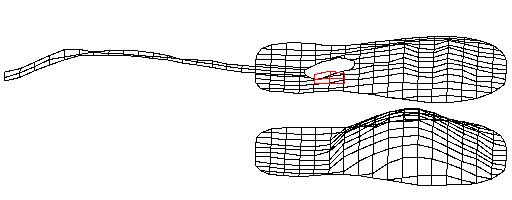Modal Analysis of an Acoustic Folk Guitar
Dan Russell, Ph.D., Applied Physics, Kettering University
Student Assistants: Paul Pedersen and Zach Hastings
The research described on this web site has been made possible by a generous donation from Gibson Musical Instruments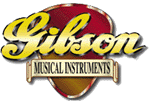
This is a work in progress. Additional results and discussion will be added as the work continues. Last updated: December 21, 1998
The images and animations on this page are Copyrighted © 1998 Daniel A. Russell, Ph.D, Science and Mathematics
Department, Kettering University, Flint, MI, USA
The Guitar: Gibson Early 1960's Hummingbird

| Soundboard Bracing |
|---|
| Top plate | Bottom plate |
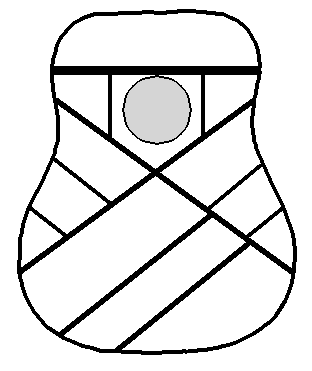 | 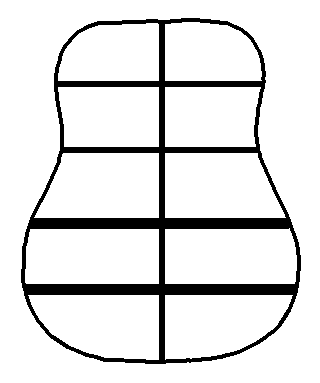 |
The following description is taken from the Gibson/Montana web pages:
Since its release in the 1960's, the Hummingbird has been luring guitar lovers with its sweet, velvet tone and distinctive appearance. This celebrity guitar, equally loved by blues, country, folk, and rock players, has become a symbol of the passionate '60s and has also earned its place in the heart-throbbing music of today. True to its original design, the Early '60s Hummingbird is handmade with a carefully applied Heritage Cherry Sunburst finish, and its authentic Gibson Hummingbird pickguard. It's honey-like tone is attributed to its Sitka Spruce top, Mahogany back and sides, 24-3/4" scale length, and its traditional construction design with includes a dovetail neck-to-body joint, scalloped bracing, and lacquer finish.
The Early '60's Hummingbird guitar is a flat-top folk guitar with a standard Dreadnought shape. Click here for the specs. The images at right show the rib bracing.
The photo at left is copyrighted by Gibson
The Experiment: Modal Analysis
Measurements were made with the strings tuned to their playing frequencies. The guitar was suspended with rubberbands - one under the neck at the nut, the other under the strap knob at the tail block. More information about experimental modal analysis will follow soon.
In the images and animations below the red square represents the experimentally measured motion of the air in the sound hole. The modal analysis for the sound hole was performed using a microphone instead of an accelerometer to measure the air motion. While we were not initially confident this would work, we were pleasantly surprised to find that the phase and amplitude of the air motion compared to the body matches what we expected for the various modes of the guitar, and also matches what has been reported in the literature.
The Low Frequency Modes
The Low Frequency modes are dominated by strong coupling between the motion of the top plate, bottom plate and air cavity. These lower frequency modes contribute very strongly to the sound radiation from the guitar.
Mode #1 - the "bending mode" - (59 Hz)
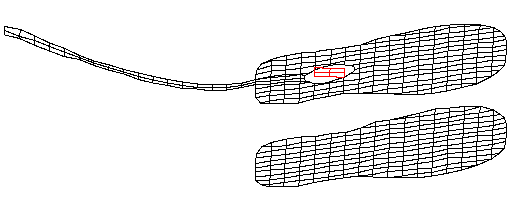 |
In this mode the guitar bends like a free-free beam. This mode probably contributes relatively little to sound radiation and the overall behavior of the guitar. An exception, perhaps, may be slight changes in the string tension as the guitar flexes.
|
Mode #2 - the "breathing mode" - (103 Hz)
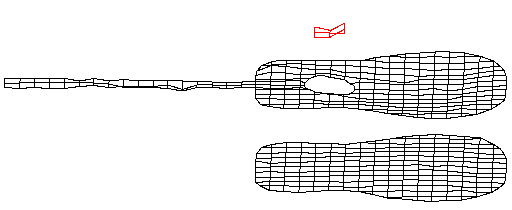 |
In this mode the guitar "breathes" - that is, as the top and bottom plates expand outwards (with opposite phase) air is drawn into the guitar cavity, and as the plates move inwards this air is expelled. This mode results from close coupling between the first vibrational modes of the top and bottom plates with the Helmholtz mode of the cavity.
|
Mode #3 (188 Hz)
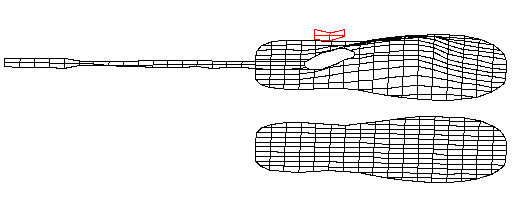 |
This mode is the first of two modes with closely spaced frequencies (188 Hz and 203 Hz) in which the top plate and the air in the sound hole move together in phase. The only difference between the two modes is the motion of the bottom plate. In the lower frequency mode (shown at left) the bottom moves with slightly opposite phase compared to the top plate, only with much less amplitude.
|
Mode #4 (202 Hz)
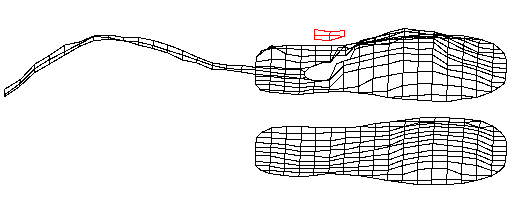 |
This mode is the second of two modes with closely spaced frequencies (188 Hz and 203 Hz) in which the top plate and the air in the sound hole move together in phase. The only difference between the two modes is the motion of the bottom plate. In this higher frequency mode the bottom moves with the same phase as the top plate. This mode also shows significant bending motion of the neck.
|
The Middle Frequency Modes
The Middle Frequency modes involve less coupling between the top plate, back plate, and air cavity, but still contribute significantly to the radiation of sound from the guitar body.
Mode #5 - the second bending mode (223 Hz)
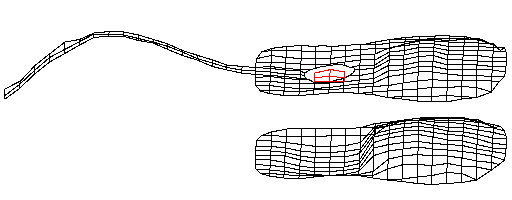 |
This mode looks very much like the second bending mode of a free-free beam. The motion of the guitar body is quite similar to mode #4. The tell-tale difference between modes 4 and 5 can be seen in the motion of the air in the sound hole. In mode #4 the air in the sound hole is moving, with significant displacement, in phase with the top plate. In moden #5 the air in the sound hole is not moving relative to the top of the plate - only the guitar body is vibrating.
|
Mode #6 - (231 Hz)
Mode #7 - the (0,1) mode (262 Hz)
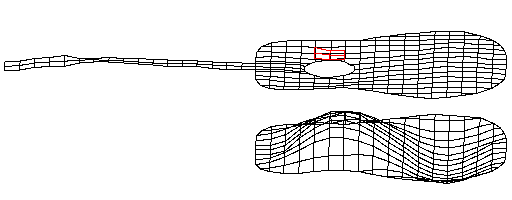 |
In this mode the top and back plates are undergoing a (0,1) type motion with one nodal line (line of zero motion) across the width of the guitar. The top and bottom plates move with opposite phase (in terms of their outward normal directions) and the top moves with much smaller relative displacement than the bottom plate. The opposite phase motion means that the air inside the guitar is primarily sloshing back and forth, and because the displacement of the bottom plate is greater than the top plate, the air in the sound hole has a net motion in and out of the guitar.
|
Mode #8 - the (1,0) mode (315 Hz)
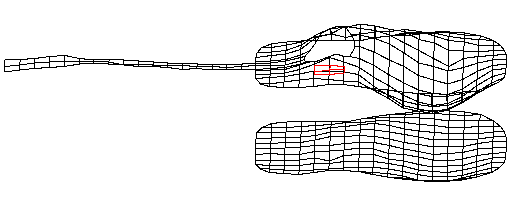 |
In this mode the top and back plates are undergoing a (1,0) type motion with one nodal line (line of zero motion) along the length of the guitar. Actually, the nodal line appears to lie directly along one of the diagonal ribs under the top plate. The top and bottom plates are moving with opposite phase (in terms of their outward normal directions) so that there is very little net motion of the air inside the guitar. As a result the air in the sound hole moves very little.
|
The High Frequency Modes
The High Frequency modes contribute much less to the overall radiation of sound from the guitar. Primarly, these modes are characterized the top and bottom plates moving independently of each other. Furthermore, the motions of the top and bottom plates are ineffective radiators of sound since several adjacent parts of the guitar move with opposite phase.
Mode #9 - the (0,2) mode - back plate (385 Hz)
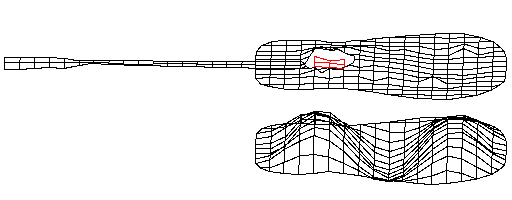 |
In the (0,2) mode there are two nodal lines across the width of the back plate. The top plate exhibits very little motion.
|
Mode #10 - the (1,1) mode - back plate (481 Hz)
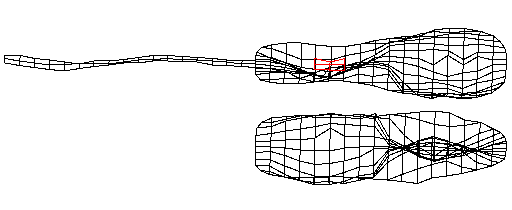 |
In the (1,1) mode there are two nodal lines, one across the width and one along the length of both the top and back plates. The top and back plates move with opposite phase so that the air in the guitar cavity simply sloshes back and forth. Since the sound hole lies on a node, there is no motion of the air out of the guitar cavity.
|
Mode #11 - combination (1,2) mode on top plate and (1,3) mode on bottom plate (749 Hz)
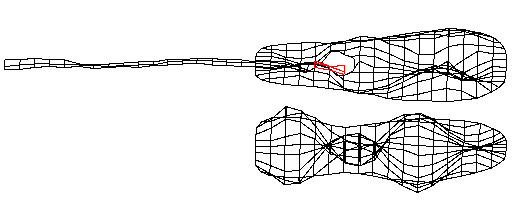 |
This vibrational pattern appears to be a combination of two different modes: a (1,2) mode on the top plate and a (1,3) mode on the bottom plate. Because of differences in stiffness and mass between the top and bottom plates, these two modes appear at the same frequency. Because each mode involves several adjacent regions moving with opposite phase, these vibrational pattern will not be an effective radiatior of sound. |
Back to the Guitar Research Page








